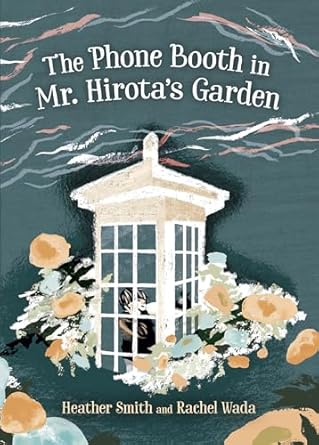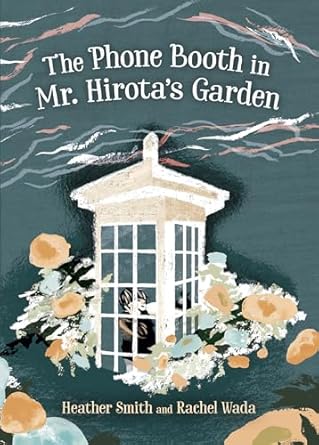Description
★ “Smith spins a quietly moving narrative...Wada’s large-scale woodblock style illustrations are a perfect complement to the story’s restrained text...The graceful way in which this book handles a sensitive and serious subject makes it a first purchase."—School Library Journal
When the tsunami destroyed Makio's village, Makio lost his father . . . and his voice. The entire village is silenced by grief, and the young child's anger at the ocean grows. Then one day his neighbor, Mr. Hirota, begins a mysterious project—building a phone booth in his garden. At first Makio is puzzled; the phone isn't connected to anything. It just sits there, unable to ring. But as more and more villagers are drawn to the phone booth, its purpose becomes clear to Makio: the disconnected phone is connecting people to their lost loved ones. Makio calls to the sea to return what it has taken from him and ultimately finds his voice and solace in a phone that carries words on the wind.
The Phone Booth in Mr. Hirota's Garden is inspired by the true story of the wind phone in Otsuchi, Japan, which was created by artist Itaru Sasaki. He built the phone booth so he could speak to his cousin who had passed, saying, "My thoughts couldn't be relayed over a regular phone line, I wanted them to be carried on the wind." The Tohoku earthquake and tsunami in 2011 destroyed the town of Otsuchi, claiming 10 percent of the population. Residents of Otsuchi and pilgrims from other affected communities have been traveling to the wind phone since the tsunami.
Author Bio
Heather Smith is the author of several picture books, including the award-winning The Phone Booth in Mr. Hirota's Garden. Her middle-grade novel Ebb and Flow was shortlisted for the Governor General's Literary Award, and her YA novel The Agony of Bun O'Keefe won the Ruth and Sylvia Schwartz Children's Book Award, the OLA Forest of Reading White Pine Award and was shortlisted for the Amy Mathers Teen Book Award and the Geoffrey Bilson Award for Historical Fiction for Young People. Most recently, Heather authored the middle-grade novel The Boy, the Cloud and the Very Tall Tale. Originally from Newfoundland, Heather now lives in Waterloo, Ontario, with her family.
Rachel Wada's work is defined by heavy texture, bold color and intricate details that capture the nuances of people, places and ideas, real and surreal. Rachel's identity as Japanese-Cantonese, an immigrant and a woman informs her artistic practice. She loves to put her own spin on traditional techniques, motifs and symbolism inspired by her cultural background. This duality of old and new is also apparent in her use of both traditional and digital mediums, and she draws inspiration from a variety of sources, from Japanese woodblock prints, Chinese pottery and ceramics, food packaging design to traditional folk art. Rachel lives in Vancouver.
Prizes
- National Consortium for Teaching about Asia (NCTA) Freeman Book Awards - Children’s LiteratureWinner 2019
- The Sakura Medal ProgramCommended 2022
- Pacific Northwest Booksellers Association (PNBA) Pacific Northwest Book AwardsNominated 2019
- BC and Yukon Book Prizes - Christie Harris Illustrated Children's Literature PrizeShort-listed 2020
- Forest of Reading Light Reads, Great StoriesCommended 2021
- Rocky Mountain Book Award (RMBA)Commended 2021
- International Board on Books for Young People (IBBY) Canada Elizabeth Mrazik-Cleaver Canadian Picture Book AwardWinner 2020
- Canadian Children's Book Centre (CCBC) Marilyn Baillie Picture Book AwardShort-listed 2020
- Kirkus Reviews Best Picture Books of the YearCommended 2019
- Children’s Book Council & National Council for Social Studies Notable Social Studies Trade Books for Young PeopleCommended 2020
- Vancouver Children’s Literature Roundtable Sheila Barry Best Canadian Picturebook of the Year Award - Honourable MentionCommended 2020
- Stiftung Internationale Jugendbibliothek The White RavensCommended 2020
- Ontario Library association (OLA) Best Bets - Honourable MentionCommended 2019
- School Library Journal (SLJ) Best BooksNominated 2019
- Bank Street College of Education Children's Book Committee Best Children's Books of the YearCommended 2019
- Forest of Reading Silver Birch Express AwardNominated 2021
- CCBC Best Books for Kids & TeensCommended 2020
- United States Board on Books for Young People (USBBY) Outstanding International Books List (OIB)Commended 2020
Review Quotes
Biographical note
Heather Smith is the author of several picture books, including the award-winning The Phone Booth in Mr. Hirota's Garden. Her middle-grade novel Ebb and Flow was shortlisted for the Governor General's Literary Award, and her YA novel The Agony of Bun O'Keefe won the Ruth and Sylvia Schwartz Children's Book Award, the OLA Forest of Reading White Pine Award and was shortlisted for the Amy Mathers Teen Book Award and the Geoffrey Bilson Award for Historical Fiction for Young People. Most recently, Heather authored the middle-grade novel The Boy, the Cloud and the Very Tall Tale. Originally from Newfoundland, Heather now lives in Waterloo, Ontario, with her family.
Rachel Wada's work is defined by heavy texture, bold color and intricate details that capture the nuances of people, places and ideas, real and surreal. Rachel's identity as Japanese-Cantonese, an immigrant and a woman informs her artistic practice. She loves to put her own spin on traditional techniques, motifs and symbolism inspired by her cultural background. This duality of old and new is also apparent in her use of both traditional and digital mediums, and she draws inspiration from a variety of sources, from Japanese woodblock prints, Chinese pottery and ceramics, food packaging design to traditional folk art. Rachel lives in Vancouver.

